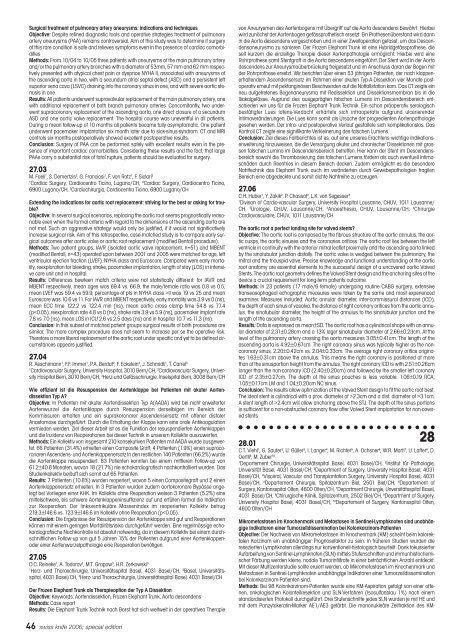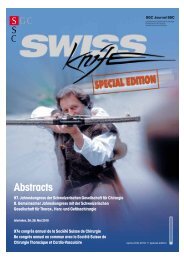Abstracts 4. Gemeinsamer Jahreskongress der ... - SWISS KNIFE
Abstracts 4. Gemeinsamer Jahreskongress der ... - SWISS KNIFE
Abstracts 4. Gemeinsamer Jahreskongress der ... - SWISS KNIFE
You also want an ePaper? Increase the reach of your titles
YUMPU automatically turns print PDFs into web optimized ePapers that Google loves.
swissknife spezial 06 12.06.2006 13:39 Uhr Seite 46<br />
Surgical treatment of pulmonary artery aneurysms: indications and techniques<br />
Objective: Despite refined diagnostic tools and operative strategies treatment of pulmonary<br />
artery aneurysms (PAA) remains controversial. Aim of this study was to determine if surgery<br />
of this rare condition is safe and relieves symptoms even in the presence of cardiac comorbidities<br />
Methods: From 10/04 to 10/05 three patients with aneurysms of the main pulmonary artery<br />
and/or the pulmonary artery branches with a diameter of 53mm, 57 mm and 62 mm respectively<br />
presented with atypical chest pain or dyspnoe NYHA II, associated with aneurysms of<br />
the ascending aorta in two, with a secundum atrial septal defect (ASD) and a persistent left<br />
superior vena cava (LSVC) draining into the coronary sinus in one, and with severe aortic stenosis<br />
in one.<br />
Results: All patients un<strong>der</strong>went supravalvular replacement of the main pulmonary artery, one<br />
with additional replacement of both branch pulmonary arteries. Concomitantly, two un<strong>der</strong>went<br />
supracoronary replacement of the ascending aorta, one direct closure of a secundum<br />
ASD and one aortic valve replacement. The hospital course was uneventful in all patients.<br />
During a mean follow-up of 10 months all patients became fully asymptomatic. One patient<br />
un<strong>der</strong>went pacemaker implantation six month later due to sick-sinus-syndrom. CT and MRI<br />
controls six months postoperatively showed excellent postoperative results.<br />
Conclusion: Surgery of PAA can be performed safely with excellent results even in the presence<br />
of important cardiac comorbidities. Consi<strong>der</strong>ing these results and the fact, that large<br />
PAAs carry a substantial risk of fatal rupture, patients should be evaluated for surgery.<br />
27.03<br />
M. Faeli 1 , S. Demertzis 2 , G. Franciosi 1 , F. von Rotz 1 , F. Siclari 3<br />
1 Cardiac Surgery, Cardiocentro Ticino, Lugano/CH, 2 Cardiac Surgery, Cardiocentro Ticino,<br />
6900 Lugano/CH, 3 Cardiochirurgia, Cardiocentro Ticino, 6900 Lugano/CH<br />
Extending the indications for aortic root replacement: striving for the best or asking for trouble?<br />
Objective: In several surgical scenarios, replacing the aortic root seems prognostically reasonable<br />
even when the formal criteria with regard to the dimensions of the ascending aorta are<br />
not met. Such an aggressive strategy would only be justified, if it would not significatively<br />
increase surgical risk. Aim of this retrospective, case-matched study is to compare early surgical<br />
outcomes after aortic valve or aortic root replacement (modified Bentall procedure).<br />
Methods: Two patient groups, IAVR (isolated aortic valve replacement, n=51) and MBENT<br />
(modified Bentall, n=43) operated upon between 2001 and 2005 were matched for age, left<br />
ventricular ejection fraction (LVEF), NYHA class and Euroscore. Compared were early mortality,<br />
reexploration for bleeding, stroke, pacemaker implantation, length of stay (LOS) in intensive<br />
care unit and in hospital.<br />
Results: Differences bewteen match criteria were not statistically different: for IAVR and<br />
MBENT respectively, mean ages was 69.4 vs. 66.9, the male/female ratio was 0.8 vs 0.5,<br />
mean LVEF was 59.4 vs 59.9, percentage of pts in NYHA class >II was 19 vs 25 and mean<br />
Euroscore was 10.6 vs 11. For IAVR and MBENT respectively, early mortality was 3.9 vs 0 (ns),<br />
mean ECC time 122.2 vs 122.4 min (ns), mean aortic cross clamp time 5<strong>4.</strong>8 vs 77.4<br />
(p3.1cm.<br />
A stent length of >2.4cm will allow anchoring above the STJ. The depth of the sinus portions<br />
is sufficient for a non-obstructed coronary flow after Valved Stent implantation for non-covered<br />
stents<br />
28<br />
28.01<br />
C.T. Viehl 1 , G. Sauter 2 , U. Güller 3 , I. Langer 4 , M. Richter 5 , A. Ochsner 6 , W.R. Marti 7 , U. Laffer 8 , D.<br />
Oertli 9 , M. Zuber 10<br />
1 Departement Chirurgie, Universitätsspital Basel, 4031 Basel/CH, 2 Institut für Pathologie,<br />
Universität Basel, 4031 Basel/CH, 3 Department of Surgery, University Hospital Basel, 4031<br />
Basel/CH, 4 Visceral, Vascular and Transplantation Surgery, University Hospital Basel, 4031<br />
Basel/CH, 5 Departement Chirurgie, Spitalzentrum Biel, 2501 Biel/CH, 6 Departement of<br />
Surgery, Kantonsspital Olten, 4600 Olten/CH, 7 Department Chirurgie, Unversitätsspital Basel,<br />
4031 Basel/CH, 8 Chirurgische Klinik, Spitalzentrum, 2502 Biel/CH, 9 Department of Surgery,<br />
University Hospital Basel, 4031 Basel/CH, 10 Departement of Surgery, Kantonsspital Olten,<br />
4600 Olten/CH<br />
Mikrometastasen im Knochenmark und Metastasen in Sentinel-Lymphknoten sind unabhängige<br />
Indikatoren einer Tumorzelldissemination bei Kolonkarzinom-Patienten<br />
Objective: Der Nachweis von Mikrometastasen im Knochenmark (KM) scheint beim kolorektalen<br />
Karzinom ein unabhängiger Prognosefaktor zu sein. In früheren Studien wurden die<br />
resezierten Lymphknoten allerdings nur konventionell-histologisch beurteilt. Dank fokussierter<br />
Aufarbeitung von Sentinel-Lymphknoten (SLN) mittels Stufenschnitten und immunhistochemischer<br />
Färbung werden kleine, nodale Tumorinfiltrate in einer beträchtlichen Anzahl entdeckt.<br />
Mit dieser Multizenterstudie sollte eruiert werden, ob Mikrometastasen im Knochenmark und<br />
Metastasen in Sentinel-Lymphknoten unabhängige Indikatoren einer Tumorzelldissemination<br />
bei Kolonkarzinom-Patienten sind.<br />
Methods: Bei 98 Kolonkarzinom-Patienten wurde eine KM-Aspiration gefolgt von einer offenen,<br />
onkologischen Kolonteilresektion und SLN-Verfahren (Isosulfanblau 1%) nach einem<br />
standardisierten Protokoll durchgeführt. Drei Stufenschnitte jedes SLN wurden je mit HE und<br />
mit dem Panzytokeratin-Marker AE1/AE3 gefärbt. Die mononukleäre Zellfraktion des KM
















